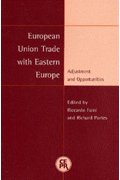The ‘Europe Agreements’ nominally provide the countries of Central and Eastern Europe (CEECs) with free access to European Union markets, but the Union has retained significant protection for certain ‘sensitive’ products. There are substantial benefits to the Union of a free trade regime with the CEECs: opening new export markets in the East, promoting the economic transformation of the CEECs, and strengthening their commitment to the liberal market economy and political democracy of the Union. Resistance to fully open policies reflects the concerns in some EU member states that free trade with the rest of the continent will economically damage their domestic industries. Others fear not just this direct competition in domestic markets but also the effect of increased competition in third markets and the possibility of investment diversion from their own countries to the CEECs. This volume explores those concerns from three approaches: cross-sectional studies of the likely long-run comparative advantage of the CEECs; the impact of opening up to the East on individual countries (France, Spain, and Greece); and the specific ‘sensitive’ sectors of steel and textiles. This book breaks new ground in analysing the actual impact of the changes in Central and Eastern Europe on trade and investment flows in Europe.
Authors
